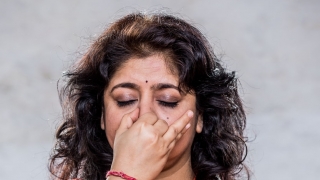
One Love
The approach of Valentine's day made me contemplate on what love really is. I keep coming back to the answer: Love Is

![]() 7 minutes
7 minutes
Yoga as Work-IN
Make bigger goals in Yoga.
Who cares if you can touch your toes or stand on your hands?
Can you sit still and be touched by waves of bliss?
Who cares if you can see the colors and feel the chills?
Can you stay centered and enjoy the thrills?
Who cares if you know the names and spell them all?
Can you experience the state and yet be humble?
Make bigger goals in Yoga.
Yes, Yoga can help release stress.
Yes, Yoga can build a strong core.
Yes, it is therapy.
Yes, it can make you enjoy deeper sleep.
Yes, Yoga can help you lose weight, and gain some, too.
But make bigger goals in Yoga.
Seek Yoga in Yoga.
We’ve all practiced with that person who looks like they have stepped right off the cover of a yoga magazine. Or maybe you’re that person. While practicing photogenic yoga poses may be a pleasant side effect of one’s yoga practice, asana is not the only goal.
Seek Yoga in Yoga.
It’s so easy to forget. With the ubiquity of the idea of yoga in our current culture, it’s easy to lose track of what yoga is really about. You know what I’m talking about…goat yoga, puppy yoga, cat yoga, beer yoga, gimmicky yoga, or yoga for the sole purpose of working out. Sometimes we need a reset, a refresher to remember what we’re doing and why! We need to go back to our roots.
Yoga is the goal of Yoga.
Stop where you are and head to your bookshelf. Pull out your copy of Patanjali’s Yoga Sutras. (Or if you don’t have one, maybe now is the time to take that next step and head to your local bookshop!) How much of the text talks about attaining the perfect posture? For that matter, how much is asana even mentioned? Exactly. Not much.
Yoga is a work-in, not a workout.
It’s not just a fun, acrobatic experience. We practice asanas to create a diversion, to still the chitta vrittis—the waves of the mind—that stand between us and what we house inside us but can’t always reach—samadhi. From sama meaning “balanced, stable, still, whole, altogether,” and dhi meaning “to hold, to place, state of gathering related to entirety of mind, higher intellect, and fill awareness,” samadhi is the true goal of Yoga. Only with the dissolution of the turbulent state of mind, can we experience the infinite expansion of our consciousness.
Yoga is a personal experience, a journey we take alone. And contrary to what we see on billboards, in magazines, or on television, yoga is a practice (in the true sense of the word) of the mind, body, and spirit. Yoga is not just in the asana or in the esoteric, theoretical discussion of yoga. You can practice yoga while talking to your family, cleaning your bathroom, or preparing a meal for the people you love.
The idea of yoga can evoke romantic visions of colorful mats, flickering candles, intoxicating incense, and an inviting, soothing studio with time-worn hardwood floors and exposed brick walls. You may imagine the community of your like-minded friends, the time-out from the hectic pace of life, the cool release of tight muscles, the calming voice of your teacher (or maybe your peaceful presence as teacher learning from your students). Yes, that’s all yoga, too. But what we need to remember is the part that’s less glamorous and more pragmatic.
Consider the standard of integrity required by the Yamas and Niyamas (the do’s and don’ts of yoga). This is where our real ability to stretch is of utmost importance.
The Yamas consist of ahimsa (nonviolence), satya (truthfulness), brahmacharya (attitude of moderation), asteya (non-stealing), and aparigraha (non-covetousness). As we reflect on our modern lives, we have multitudes of opportunities on any given day to extend our selves through the practice of the Yamas.
How many people are quick to say “I’m stupid, I forgot that…” or to talk about how they hate the way their body looks? Learn to recognize violence (ahimsa) against the self so you can stop the harm. Have you told yourself untruths like “It doesn’t matter if I do this little thing, it won’t hurt anyone,” or “I’m not going to put up with this or that anymore…?” Are those things true for you? Satya is the non-telling of lies/maintaining of truthfulness, especially to the self. Brahmacharya (moderation) is especially easy to recognize around mealtimes. How much food do you need (versus want)? Do you stop there? [Note: The cupped hands (anjali) mirror the size of the stomach. Eating more than this taxes the digestive system and other organs as they work to purify the body, and excess food results in the buildup of toxins (ama).] Asteya is one that’s easy to miss sometimes. It’s more than the obvious stealing of things. When arriving late for a meeting or interrupting someone’s work needlessly, is it not the stealing of time? Do you give credit to authors and artists whose resources you draw from? And going back to our yoga magazine cover model. Are you coveting your neighbor’s abilities or knowledge (aparigraha)?
In the Niyamas, we have guidance for right living: saucha (cleanliness), santosha (contentment), tapas (heat of practice), swadhyaya (study of self), and ishwara pranidhana (surrender to divinity). You maintain your car, your bike, your house, right? Are you showing the same kindness to yourself through the practice of hygiene and kriyas to support your mental, physical, spiritual and emotional self (saucha)? Are you allowing yourself to recognize and experience contentment in your life? At the end of asana practice, do you feel satisfied or do you focus on that pose you didn’t quite reach? When you prepare a meal for friends or family, do you see the love and happiness shared or do you see the cake that’s a little bit misshapen and the beans that weren’t as tender as you wanted? Build your practice of santosha. Tapas is the building of discipline. Do you practice by fasting, performing asana, practicing rituals, taking vows, or sankalpa? Have you created time in your life for self-study (swadhyaya)? You may choose to read a sloka of the Mahabharata each day. Reread (or read) the Yoga Sutras. Give it time to sink in, reflect on it. Or contemplate, meditate on things of personal importance in your life. Finally, surrender your experiences (good and bad) and the fruits of your practice to the lineage of realized beings. Idam na mama. It is not mine.
So, take these eight limbs of yoga and make them your own. Bend them like young tree boughs so that as the days pass, they become the solid foundation of your yoga practice and your life. And in those times when you are feeling anxious because you missed yoga class all week, remember that yoga is not what happens for an hour when we walk through the studio doors. Yoga lives in the dynamic moment-to-moment details of everyday life. Don’t do yoga, be Yoga.
Don't Do Yoga, Be Yoga!
Learn about Yamas, Niyamas and more in Yoga, Ancient heritage, tomorrow's vision
Start your FREE subscription to Indu Arora's newsletter to get more on Yoga and Ayurveda here

The approach of Valentine's day made me contemplate on what love really is. I keep coming back to the answer: Love Is

In conversation with Kino MacGregor, precious memories are shared about meeting her teachers for the first time.

Commonly, pranayama is considered manipulation, stretching, holding of breath or maybe the name of some techniques like anulom viloma, bhastrika, ujjayi etc. The techniques are simply to remove the friction at the various points of entry of the prana into the body.These techniques itself are not pranayama, their consequence is and could be...